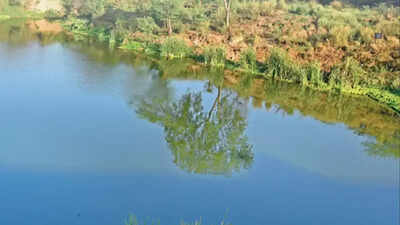Top Searches
- News
- City News
- delhi News
- Delhi govt to turn 2 revived lakes into recreational spots

To transform Delhi into a “city of lakes”, the government is reviving 23 lakes and 250 other waterbodies in the first phase
NEW DELHI: The Delhi government is working to develop two revived lakes in Burari into recreational spots.
“Local waterbodies are moderators of local climate, public relief and recreation. In situ treatment techniques will help clean water in a cost-effective manner. Cleaning will not only remove pollution from the waterbodies naturally, but also amplify plant life and through them, animal and bird life. The indigenous technology will play an active role,” said water minister Satyendar Jain during an inspection.
To transform Delhi into a “city of lakes”, the government is reviving 23 lakes and 250 other waterbodies in the first phase. According to Jain, a waterbody in Satya Vihar and another at Lakshmi Vihar Extension Colony near the subdivisional magistrate’s office have been revived using natural methods.
The lake in Satya Vihar, spread over 13,371 square metres, was earlier used by locals as a solid waste dumping site and the polluted water from the surrounding drains was being released into it.
The “constructed wetland-based” treatment system uses specific plants that absorb nutrients directly from sewage or polluted water, but do not require soil. These plants act as nutrient sinkers and removers. The raw sewage is first transferred into a settling tank from where it flows into a wetland bed. The treated water is then collected in a tanker and eventually released into the lake.
The “Burai 991” lake in the Lakshmi Vihar Extension Colony, spread over 6,500 square metres, is being treated with the “floating rafter” water pollution treatment technology, in which rafters holding hormonally treated plants remove pollutants..
“Local waterbodies are moderators of local climate, public relief and recreation. In situ treatment techniques will help clean water in a cost-effective manner. Cleaning will not only remove pollution from the waterbodies naturally, but also amplify plant life and through them, animal and bird life. The indigenous technology will play an active role,” said water minister Satyendar Jain during an inspection.
To transform Delhi into a “city of lakes”, the government is reviving 23 lakes and 250 other waterbodies in the first phase. According to Jain, a waterbody in Satya Vihar and another at Lakshmi Vihar Extension Colony near the subdivisional magistrate’s office have been revived using natural methods.
The lake in Satya Vihar, spread over 13,371 square metres, was earlier used by locals as a solid waste dumping site and the polluted water from the surrounding drains was being released into it.
The “constructed wetland-based” treatment system uses specific plants that absorb nutrients directly from sewage or polluted water, but do not require soil. These plants act as nutrient sinkers and removers. The raw sewage is first transferred into a settling tank from where it flows into a wetland bed. The treated water is then collected in a tanker and eventually released into the lake.
The “Burai 991” lake in the Lakshmi Vihar Extension Colony, spread over 6,500 square metres, is being treated with the “floating rafter” water pollution treatment technology, in which rafters holding hormonally treated plants remove pollutants..
FOLLOW US ON SOCIAL MEDIA
FacebookTwitterInstagram
Looking for Something?

Start a Conversation
end of article

